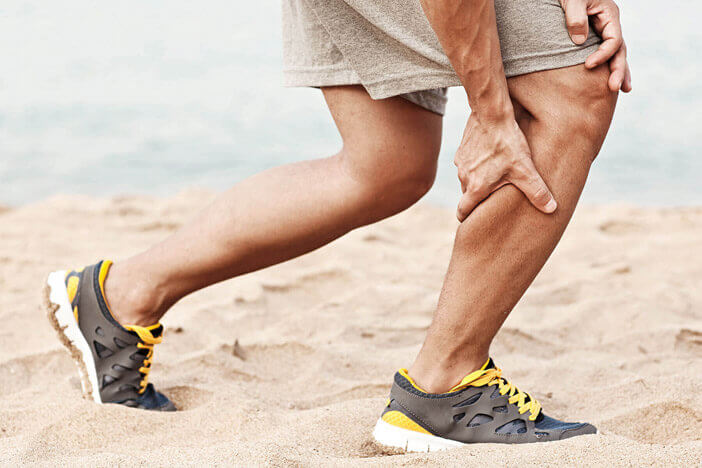DOMS (delayed onset muscle soreness): What is it actually and what can you do about it?

- Introduction
- What is DOMS (delayed onset muscle soreness)?
- How does DOMS develop?
- How does DOMS manifest?
- Progression of DOMS
- Myths about DOMS
- Is it OK to train with DOMS?
- Tips to prevent DOMS
- How can you reduce DOMS?
- Diet for sore muscles
- Food which help against DOMS
- Supplements
- Final recommendations for DOMS
- Frequently Asked Questions
- Sources
Introduction
Who doesn’t know the feeling? After an intense workout, you feel muscles that you never knew you had. We have all experienced sore muscles but what is really causing them to be sore? Should you continue training as usual or take a break? And what can you do to make the lousy pain go away as quickly as possible?
Continue reading for answers to these questions and many more.
What is DOMS (delayed onset muscle soreness)?
Muscle soreness describes a delayed onset of muscle pain after an intense workout.
These are tiny injuries in the muscle fibre called micro traumas.
Basically, it is important to distinguish between functional and structural muscle injuries. Functional muscle injuries include damage to the muscles, e.g. muscle soreness, but also cramps, stiffness and strains.
Structural injuries, e.g. muscle fibre tears, are more serious than functional injuries. However, if functional injuries are not recognised and treated at an early stage, the risk of serious secondary injuries increases.
How does DOMS develop?

The following are considered to be the most likely causes of DOMS:
- Unaccustomed loads or movement sequences
- Particularly intense physical stress
- Physical activity after a long period of inactivity (i.e. a long period of inactivity from exercise).
- Eccentric muscle contractions (in this part of the movement the muscle works in a yielding manner. An eccentric contraction occurs during slowing down movements, for example during landing when hopping).
- Skipping a warm-up or doing it incorrectly
How does DOMS manifest?
The symptoms of muscle soreness do not occur during exercise, but are delayed. Most of the time you will feel the soreness the day after the workout.
Most people describe muscles that are:
- Sensitive to touch
- Swollen
- Stiff and aching
- Weak, lacking strength and challenging to move
Progression of DOMS

The muscle pain usually lasts for 2-3 days. In rare cases, the pain can last up to 5 days. Exactly how long the pain lasts depends on individual factors such as age, training level and intensity, and the muscle group being trained.
If you continue to have severe pain after a week, it is probably not DOMS and you should see a doctor.
Myths about DOMS
There are a multitude of claims about muscle pain. We’ll show you which of these are myths.
Sore muscles are due to hyperacidity
In the past, it was increasingly claimed that muscle soreness was caused by lactic acid, or lactate. Lactic acid is produced in the muscles as a result of exercise, but this is not the cause of muscle soreness. Incidentally, if there is a large accumulation of lactate, the muscle’s performance is inhibited.
DOMS can be trained away
This assumption is wrong. Doing another demanding workout the day after an intense workout may slow down the recovery process and cause injury to your muscles. This in turn can lead to a longer disruption of your training. However, you can do some light training. To avoid a break, you can simply do an upper body workout after a strenuous leg workout. This allows the area affected by DOMS to take a break.
It is only muscle soreness that leads to muscle building
This is wrong. Even in a hard workout without subsequent DOMS, you can set sufficient stimuli for muscle building. On the flip side, even though your muscles are sore, you may not have had enough stimuli to build them up.
So DOMS should not be used as a measure of muscle growth. The right workout and the right diet are much more important.
However, you should not always train at the same level, but always set new stimuli so that your muscles grow.
Stretching helps against DOMS
You often hear that stretching helps DOMS or prevents them.
Empirically, however, these assumptions cannot be confirmed (Wunderlich, 2016). On the contrary: Hofmeister (2012) found that intensive stretching before or after a hard workout in which microtrauma has occurred can promote or even trigger DOMS. Static stretching in particular increases the risk of injury before the actual exercise. However, dynamic stretching is recommended by some athletes.
Tip: Find out here how to stretch properly and the difference between static and dynamic stretching.
Is it OK to train with DOMS?

It is difficult to give a clear answer to this question because pain is ultimately subjective. As a rule, there is nothing to be said against light, low-intensity training, especially if it has a regenerative effect. You can do targeted aerobic endurance training, such as swimming, jogging or cycling. The basic rule is this:
The more severe the pain, the lower the exercise intensity should be.
Once the DOMS is resolved, the body can be put under greater strain again.
Tips to prevent DOMS
Before your workout
- Do an effective warm-up
- Start off with exercises without weight or with a minimum weight.
During your workout
- Start with a low intensity and then increase it (e.g. duration of the exercise session / weight), a training plan can help you with this.
- After a longer break from training, you should not immediately start with your last completed intensity.
- Execute the technique cleanly (you should be particularly controlled with eccentric muscle movements).
After your workout
- Cool down after the training session
Generally speaking, you should exercise regularly. If you are more trained, you are less likely to get DOMS. Don’t forget to increase the intensity of the workout so that your body doesn’t get used to the exercises.
How can you reduce DOMS? 5 tips to get rid of DOMS fast!

If you already have sore muscles, there is unfortunately no miracle cure that will help you get rid of them straight away.
However, our 5 tips will help you to be pain-free again quickly.
Tip 1: Take a break! Rest and respite
If you have severe DOMS, it is best to give the affected muscles a rest. The muscles are overstrained and now need time to repair themselves. Further strain will hinder recovery and, in the worst case, can increase muscle soreness.
Tip 2: Get rid of DOMS with heat
Whether it’s a visit to the sauna, heat pads or a soak in the hot tub, warming the affected muscle groups increases blood circulation and thus ensures that the muscle soreness subsides more quickly. Alternating showers are also helpful: taking alternating hot and cold showers stimulates muscles even more!
Tip 3: Light exercise helps DOMS
You also must not sit on the sofa and wait for the pain to subside.
Light exercise can help the body renew muscle cells because it stimulates circulation and metabolism. Blood circulation increases and the muscles are supplied with more oxygen and nutrients. So if you have sore thigh muscles, you shouldn’t go for a fast run but for a short walk instead.
Tip 4: Avoid strong massages and stretching and go for a foam roller or light massages instead
Many athletes now swear by this new form of self-massage: the foam roller aka the fascia roller! Foam rolling is quite simple: take a foam roller and roll over it with the parts of your body that are suffering from DOMS. This loosens the fasciae. Fasciae are connective tissues that coat muscles and organs. Loosening the fasciae is also said to improve circulation.
Tip 5: These home remedies help against sore muscles
Topical pain relief ointments containing arnica help best. Pain relief ointments contain various mixtures of active ingredients, including:
- Rosemary oil
- Camphor
- Arnica
- Menthol
- Capsaicin
All these active ingredients have one thing in common: they stimulate blood circulation and can thus relieve muscle pain.
A small dose of painkillers (ibuprofen is best) can also help relieve sore muscles. But be careful! Those who no longer feel the pain also tend to put (a lot of) strain on their muscles again.
Diet for sore muscles
Nutrition is a crucial factor when recovering from injuries and after intense training sessions.
In general, you should keep hydrated. You can drink water, but also green tea, which has an anti-inflammatory effect.
In the following section, you can read exactly which foods you should eat and what they do.
Food which help against DOMS
| Ingredient | Foods | Benefits |
|---|---|---|
| Magnesium | Whole grain products, oatmeal, nuts, pulses | Stimulates the regeneration of muscle tissue and relieves symptoms. |
| Creatine | Especially in fish and meat | Often accelerates recovery from muscle-damaging exercises and reduces pain. It also causes muscle mass to grow. However, too much creatine can be harmful, so stick to the recommendations on the label. |
| Essential amino acids: Lysine | Soy products, lentils, amaranth, oatmeal, fish | Our body cannot produce essential amino acids itself, so it is important to consume them in a targeted way. Lysine improves the repair of all protein structures. |
| Omega-3 fatty acids | Oily fish | Reduces symptoms and improves recovery from muscle-damaging exercise. It also reduces the risk of further muscle soreness. |
| Anti-inflammatory plant substances | Cherries or spices: turmeric | Reported as making sore muscles disappear more quickly, reducing symptoms and having an anti-inflammatory effect. However, there are no studies on this yet. |
| Enzymes that reduce inflammation | Pineapple, papaya | Counteract inflammation, especially when the fruits aren’t yet fully ripe. |
| Protein | Egg, fish, meat, dairy products, pulses, cereals, nuts, soya products | Protein repairs small tears in the muscle fibres. |
| Vitamin D | 90% of the source of vitamin D is exposure of the skin to sunlight | Vitamin D reduces the risk of stress fractures and improves adaptation to training. |
(according to Wessinghage, 2009 & Pöttgen, 2019)
Supplements

There are many reports circulating the internet about athletes who swear by dietary supplements. You often hear about omega-3 fatty acids or L-carnitine, which are said to improve symptoms of DOMS or allegedly have a preventive effect. However, research has not yet reached a consensus about their alleged effects on DOMS.
Omega-3 fatty acids
Regarding the specific intake of omega-3 fatty acids for sore muscles, Pöttgen (2019) says: “The best recommendation may be to consume foods rich in omega-3 fatty acids, such as oily fish, rather than to take supplements. […] It is unclear […] whether supplementation should [still] be made”. In the worst cases, omega-3 fatty acids could lead to bleeding or digestive problems.
L-Carnitine
L-Carnitine is said to have a performance-enhancing effect, although this has not been scientifically proven. For vegans and vegetarians, however, supplementing with L-Carnitine makes sense because we mainly absorb it from red meat.
Final recommendations for DOMS
If your symptoms of DOMS are only mild, you can continue to train at a low intensity. If the muscle pain is very severe, then further exercise should be put on hold. Particular measures such as heat treatment and good nutrition are excellent ways to accelerate the healing process in the case of severe DOMS. However, to prevent DOMS in the first place, you should build up your training gradually and warm up beforehand.
Frequently Asked Questions
Can training with DOMS cause injury?
Training with DOMS can cause injury. If you give your muscles a break after a hard workout, sore muscles are not dangerous and they usually disappear after about five days. However, if you do not take a break and still train, you may suffer consequential damage.
Does DOMS mean muscle growth?
Unfortunately, muscle soreness is not a clear measure of muscle gain. Even without muscle soreness, your workout can effectively stimulate the muscles. However, you should always increase the intensity of your training little by little to ensure you continue to challenge your body.
How can you reduce DOMS?
To counteract the pain, you can use heat therapy in the form of sauna sessions or a hot bath. You can also try a self-massage with a foam roller or carry out light exercises, focussing on aerobic endurance training, such as jogging or cycling.
Sources
- Boeckh-Behrens, W.-U. & Buskies, W. 2012. Fitness-Krafttraining: Die besten Übungen und Methoden für Sport und Gesundheit. 15. Auflage. Reinbek bei Hamburg: Rowohlt
- DOSB: Nahrungsergänzungsmittel Deutscher Olympischer Sportbund, 1. Auflage, Frankfurt am Main, Juni 2014
- Hofmeister, M. 2012. Verhindert Dehnen Muskelkater und Verletzungen? Ernährung & Medizin 27(3), 104-105
- Mathias, D. 2018 Fit und gesund von 1 bis Hundert. 4. Auflage. Berlin, Heidelberg: Springer
- Meyer, T., Faude, O. & aus der Fünten K. 2014. Sportmedizin im Fußball. 1.Auflage. Aachen: Meyer & Meyer Fachverlag
- Müller-Wohlfahrt, H.-M. & Jürgen, H.-M. 2005. Verletzt… was tun? Hilfe zur Selbsthilfe bei Sportverletzungen! 3. Auflage. Pfaffenweiler: Weropress
- Neumann, G. 2016 Ernährung im Sport. 8. Auflage. Aachen: Meyer & Meyer Verlag
- Pöttgen, M. Dr. med. 2019. Ernährung im Sport: IAAF (Leichtathletik) Konsensus Papier 2019 Sportärztezeitung 04/2019, 90-95
- Schoser, B. 2009. Zur Therapie von Muskelkater, Myalgien, Krampi und Myotonie. Aktuelle Neurologie 36(5), 270-274
- Siebert, C. H., Breuer, C., Krüger, S. & Miltner, O. 2004. Tipps und Tricks für den Sportmediziner. 1. Auflage. Berlin, Heidelberg: Springer.
- Torres, R., Pinho, F., Duarte, J.A. & Cabri, J.M. 2013. Effect of single bout versus repeated bouts of stretching on muscle recovery following eccentric exercise. Journal of Science and Medicine in Sport 16(6), 583-588
- Weineck, J. 2010. Sportbiologie. 10. Auflage. Balingen: Spitta
- Wessinghage, T., Feil, W. & Ryffel, J. 2009. Sportverletzungen von A – Z: Gesundheits-Coach. 1. Auflage. Stuttgart: Haug
- Wunderlich, S. 2016. Wissen zur Muskeldehnung. VPT Magazin 02(09), 16-17
- https://www.verbraucherzentrale.de/wissen/lebensmittel/nahrungsergaenzungsmittel/kreatin-nur-in-seltenen-faellen-hilfreich-8089



